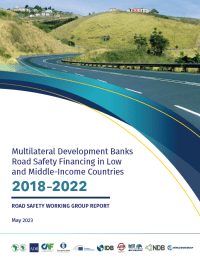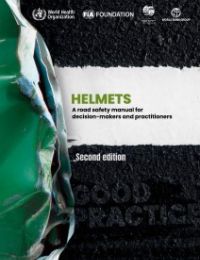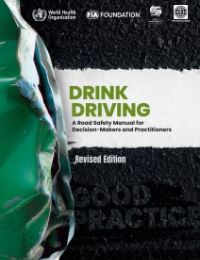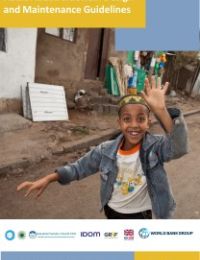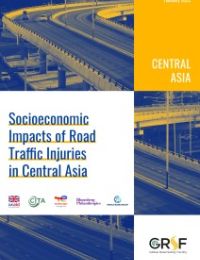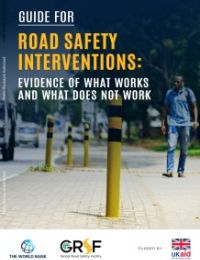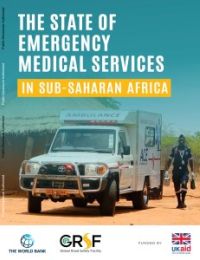Publications
11-20 of 48
-
Economics & Finance
Multilateral Development Banks Road Safety Financing in Low and Middle-Income Countries: 2018–2022
May 2023
-
-
Road Users
Drink-Driving: A Road Safety Manual for Decision-Makers and Practitioners (2nd ed.)
November 2022
-
-
-
- international literature and good practices on motorcycle safety;
- assessment of motorcycle crashes, regulations, risk exposure data, risk indicators in African countries (with more detailed analysis of Burkina Faso, Cameroon, Rwanda, and Uganda); and
- consultations with stakeholders.
-
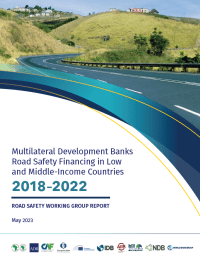
The Multilateral Development Banks (MDBs) Road Safety Working Group, established in 2009, is comprised of ten member institutions that are uniquely positioned to support countries in reaching their considerable and challenging road safety financing needs.
In early 2023, the working group reviewed progress made by the MDBs in financing road safety activities in low and middle-income countries (LMICs), and found that MDBs collectively committed $3.6 billion toward road safety initiatives in developing countries during the period 2018-2022. Three standalone road safety projects—in Bangladesh (World Bank), India (Asian Development Bank and World Bank), and Romania (European Investment Bank)—totaled $912 million in MDBs financing, which is more than one-quarter of the amount committed during this timeframe.
The review is based on details of road and urban mobility project financing provided by seven of the working group's ten members.
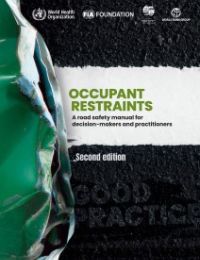
This manual provides guidance and evidence for decision-makers and practitioners that should lead to an increase in the use of vehicle occupant restraints, such as seat-belts for adults and car seats for babies and children. It draws on experience from countries that have succeeded in achieving and sustaining high levels of vehicle occupant restraint use, and builds on new evidence, including from low and middle-income countries.
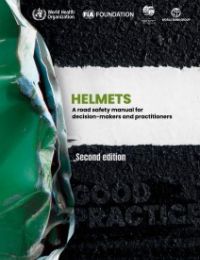
Safe, quality helmets reduce the risk of death in a road crash by over six times, and reduce the risk of brain injury by up to 74%. Head trauma is the leading cause of death for riders, and motorcycles continue to proliferate rapidly. Yet the use of helmets in many low and middle-income countries remains low.
The second edition of the Helmets Manual offers guidance to help decision makers and practitioners put in place the comprehensive set of laws, regulations and actions needed to increase the use of safe, quality helmets to save lives.
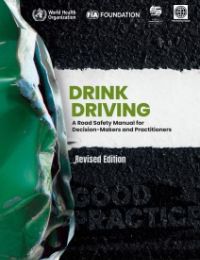
This manual provides guidance for decision-makers and practitioners to reduce the prevalence of drink driving and associated road trauma. It draws on experience from countries that have succeeded in achieving and sustaining reductions in alcohol-related road trauma, and includes recommendations for developing and implementing drink driving legislation, and advice on how to monitor and evaluate progress.
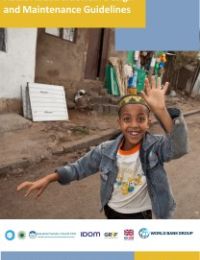
Walking is a predominant mode of travel in Addis Ababa representing more than half of the daily trips. The mild climate in Addis Ababa is conducive for this healthy and green mode of transport. However, sidewalks are often narrow, uneven, obstructed, or non-existent, causing discomfort and road safety risks to the most vulnerable road users: pedestrians. Studies done by the WHO and the Government showed that AA has disproportionately high pedestrian fatalities.
The study on Addis Ababa Sidewalk Safety and Improvement takes the approach of integrating digital technology and Urban Inventory in sidewalk surveys, applies the Global Walkability Index in sidewalk assessments, and adapts the global best practice to the local context. The Addis Ababa Sidewalk Design and Maintenance Guidelines seek to promote the development of quality pedestrian infrastructure and environments, based on the condition’s assessment and global best practices. The design specifications and visual rendering provide recommendations for the policy makers to consider when developing the City’s design and maintenance standards for urban roads, sidewalks, public spaces, and transit-oriented development, some of which are being carried out as part of the technical assistance program of the World-Bank financed Transport Systems Improvement Project (TRANSIP).
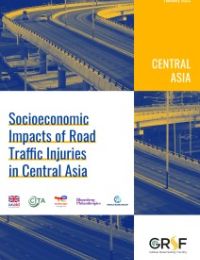
Road traffic injuries (RTIs) are well known to cause enormous human suffering in terms of both morbidity and mortality, and on a global scale. The economic dimension of the disease burden is far less well understood; but it is important to assess the size of the economic burden so that it can be considered when calculating the cost-benefit ratio of policies to tackle this problem. Because it is, in principle, and to some degree, an avoidable one.
This report focuses primarily on assessing various dimensions of the economic consequences of RTIs, as applied specifically to four Central Asian countries (Kazakhstan, Kyrgyzstan, Tajikistan, and Uzbekistan) – a part of the world in which there is still a major need to reduce RTIs.
This study shows that on top of the harm RTIs inflict upon human health, they also impose a considerable financial burden on health care systems. In 2016, the total estimated health costs of RTIs in these four countries was approximately Int$95 million, ranging from Int$2.8million in Tajikistan to Int$49.3 million in Kazakhstan. In Kazakhstan, the overall health costs resulting from RTIs were similar to the cumulative expenditure for rehabilitative and palliative care within the state-guaranteed basic package. The heavy financial burden on health care systems to manage RTIs in these countries adds weight to the urgency to increase preventive efforts by road safety policymakers, and should motivate appropriate organization of the post-crash response by health care system decision makers. The cost estimates discussed in this report indicate the potential for significant economic cost savings if both deaths and injuries from road crashes could be substantially reduced in these countries.

In developing countries with inadequate public transport and road infrastructure, motorcycles present a fast, cheap, and efficient transport alternative. Motorcycles are widely used in many African countries for personal and public transport, as well as for service delivery. In some African countries, motorized two and three-wheelers constitute the largest proportion of the motorized vehicle population. However, despite their benefits, motorcycles expose their riders and passengers to a high risk of serious injury or death in the event of crashes. Motorcycle safety is therefore a significant problem in Africa. On average, 22.5% of road traffic deaths in 2016 involved riders/passengers of two- and three-wheelers, according to the last data published by World Health Organization (WHO, 2018).
This research study presents comprehensive strategic recommendations on how to improve motorcycle safety in Africa. The study will serve as policy advice and technical assistance to the Bank’s regional member countries (RMCs). The study focuses on motorcycle safety conditions in Cameroon, Burkina Faso, Rwanda, and Uganda, where the use of motorcycles for daily activities is reputedly high. Recommendations are predicated on an examination of the major causes of motorcycle crashes and injuries, as well as an extensive body of knowledge from various sources, notably:

Les accidents de la route entraînent environ 1,35 million de décès et 50 millions de blessures dans le monde chaque année, dont plus de 90 % se produisent dans les pays à revenu faible ou intermédiaire (PRFI). Outre la douleur et la souffrance évidentes que cela inflige aux individus et aux communautés, ces décès et blessures représentent également un lourd fardeau financier, en particulier pour les PRFI, en ralentissant la croissance économique.
L’ampleur de la réponse actuelle à cette crise continue ne correspond pas à l’ampleur du problème. De plus, les ressources limitées consacrées à la sécurité routière sont souvent dépensées pour des interventions inefficaces ou sous-optimales. Bien que les connaissances en matière de sécurité routière se soient améliorées au cours des dernières décennies, il est encore nécessaire d'améliorer la prise de décision lors de la sélection et de l'application d'interventions efficaces basées sur des preuves. Les interventions efficaces sont celles qui réduisent les blessures mortelles et graves.
Le Global Road Safety Facility (GRSF) de la Banque mondiale a élaboré ce guide basé sur des preuves intitulé « Ce qui fonctionne et ce qui ne fonctionne pas » en matière de sécurité routière en réponse au besoin critique de solutions efficaces basées sur des preuves.
Ce guide a été préparé pour aider les lecteurs à comprendre que toutes les interventions en matière de sécurité routière ne sont pas également efficaces et que ce qui semble être des approches « de bon sens » pour choisir des interventions de sécurité routière ne sera souvent pas le meilleur choix. Bien que certaines apportent des avantages, d'autres ont des impacts très limités voire négatifs, malgré le fait qu'elles soient couramment – et à tort – recommandées ou acceptées. Le guide offre une gamme de recommandations en mettant l'accent sur les interventions dans les PRFI, bien que les informations puissent également être pertinentes pour tous les pays. Le contenu sera précieux pour ceux qui travaillent sur la sécurité routière au niveau des politiques ou des praticiens, y compris les chefs d'équipe techniques de la Banque mondiale et d'autres personnes cherchant à établir, développer ou améliorer des programmes de sécurité routière dans les PRFI.
Le guide situe les connaissances sur les interventions basées sur des preuves dans un contexte de « Système sûr », en fournissant des conseils sur chacun des piliers du Système sûr (gestion de la sécurité routière, routes sûres, vitesses sûres, véhicules sûrs, usagers de la route sûrs et soins post-accident) tout en reconnaissant que les solutions basées sur des preuves doivent être tirées de tous les piliers pour produire des résultats efficaces en matière de sécurité routière. Au cœur de ce document se trouve un tableau récapitulatif avec un aperçu des interventions bénéfiques et non bénéfiques basées sur des preuves scientifiques solides. Cela est suivi d'informations plus détaillées, y compris des études de cas et des références à la base de preuves pour soutenir le résumé.
De nombreuses interventions sûres sur les routes sont recommandées pour adoption, y compris les transports publics intégrés, les systèmes de barrières latérales et centrales, les médianes, les infrastructures pour soutenir une vitesse de fonctionnement appropriée pour les usagers de la route, les giratoires, la séparation de niveau et les interventions pour réduire l'exposition aux risques aux intersections, les trottoirs et passages piétons, les installations séparées pour les bicyclettes et les motocyclettes, et les panneaux de signalisation et le marquage au sol (y compris le marquage tactile-audio). Certaines de ces interventions sont très efficaces, avec une réduction allant jusqu'à 70 ou 80 % des décès et des blessures graves (par exemple, les barrières de sécurité et les giratoires).
Diverses interventions liées à la vitesse produisent également des avantages significatifs, certaines étant capables de presque éliminer les décès et les blessures graves. Des exemples d'interventions efficaces sur la vitesse incluent le ralentissement de la circulation (y compris les ralentisseurs et les chicanes), les giratoires, les intersections et passages surélevés, les traitements d'entrée, les limites de vitesse inférieures (y compris les zones de 30 km/h (20 mph) pour les piétons) et les radars automatiques.
Diverses interventions basées sur les usagers de la route ont été mises en œuvre au fil des ans, avec des exemples efficaces incluant une pratique supervisée extensive sur la route et/ou des systèmes de permis de conduire gradués dans le cadre du système de délivrance des permis de conduire, une augmentation de l'âge d'admissibilité au permis de conduire, une formation et des tests de perception des dangers, l'éducation et les campagnes publiques dans le cadre d'une stratégie intégrée (en particulier la communication sur l'application de la loi pour augmenter la dissuasion générale), l'application de la loi, les pénalités, les verrous d'alcool, la surveillance de la fatigue et de la vitesse, et l'augmentation des taux de port du casque.
Les principales interventions basées sur les véhicules comprennent l'application de normes minimales de sécurité des véhicules et les évaluations des véhicules (via le Programme mondial d'évaluation des voitures neuves, ou « NCAP »), les ceintures de sécurité, l'entretien périodique des véhicules, les feux diurnes, les pare-chocs arrière sur les camions, le contrôle électronique de la stabilité et d'autres technologies avancées pour les véhicules.
Les soins post-accident améliorés peuvent également produire de meilleurs résultats en matière de sécurité routière, y compris des systèmes pour améliorer le temps de réponse d'urgence, de meilleurs soins d'urgence, une amélioration des compétences en premiers secours pour le public et une amélioration des soins hospitaliers.
Tout aussi important, le rapport identifie également des exemples clairs où les interventions ne sont pas efficaces. Les pires de ces interventions sont celles qui augmentent le risque. Cela inclut l'augmentation de la vitesse de déplacement sans améliorer la qualité des infrastructures de sécurité, la plupart des formes d'éducation et de formation des conducteurs et motocyclistes après l'obtention du permis, et de nombreuses (mais pas toutes) formes d'éducation des conducteurs en milieu scolaire (telles que celles qui cherchent à améliorer les compétences de conduite). L'augmentation du risque est généralement due au fait que ces initiatives augmentent le niveau de confiance, conduisant à une prise de risque accrue. D'autres interventions qui n'ont pas démontré de bénéfices pour la sécurité doivent être évitées. Cela inclut les systèmes de permis via demande ou paiement, les programmes de formation ou d'éducation dans les écoles visant à améliorer les connaissances en matière de sécurité routière (y compris les visites ad hoc d'experts ou d'enthousiastes en sécurité routière), et les campagnes d'éducation menées isolément.
Il existe des interventions alternatives efficaces pour chacune de celles-ci comme décrit dans ce document, et elles devraient être appliquées à la place. Il est extrêmement important que les ressources ne soient pas gaspillées sur des interventions inefficaces au nom de la sécurité routière, mais plutôt que des interventions de sécurité routière basées sur des preuves soient mises en œuvre.
Il existe une variété de documents disponibles sur la question de l'efficacité des interventions en matière de sécurité routière, dont beaucoup sont référencés ici. Cependant, il existe quelques points clés de différence et de valeur ajoutée dans ce guide, y compris une synthèse des preuves sur un large éventail d'interventions et un contraste entre les interventions efficaces et non efficaces, permettant aux lecteurs de comparer les options. Lorsqu'une intervention non efficace est identifiée, des interventions efficaces viables sont fournies, soutenant ainsi la prise de décision. Le guide offre également des conseils directs à ceux qui travaillent dans les PRFI, en s'appuyant sur des sources d'information clés lorsque celles-ci sont disponibles. De manière importante, des preuves concises mais robustes sont fournies pour chacun des piliers du Système sûr.
Il est nécessaire de continuer à renforcer la base de connaissances sur les interventions efficaces en matière de sécurité routière, en particulier dans les PRFI où il existe un certain nombre de lacunes en matière de connaissances. Le contenu de ce guide représente un résumé utile et à jour des connaissances actuelles pour application.
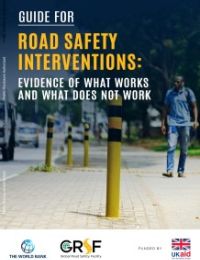
Road traffic crashes result in an estimated 1.35 million deaths and 50 million injuries worldwide per year with over 90 percent of these occurring in Low-Middle Income Countries (LMICs). Aside from the obvious pain and suffering this inflicts on individuals and communities, these deaths and injuries also place a large financial burden particularly on LMICs, by slowing economic growth.
The scale of the current response to this continuing crisis does not match the size of the problem. In addition, limited road safety resources are often expended on ineffective or suboptimal interventions. While road safety knowledge has improved over recent decades, there is still a need to improve decision making when selecting and applying effective evidence-based road safety interventions. Effective interventions are those that reduce fatal and serious injuries.
The World Bank's Global Road Safety Facility (GRSF) has developed this evidence-based guide on “What Works and What Does Not Work” in road safety in response to the critical need for effective evidence-based solutions.
This guide has been prepared to help readers understand that not all road safety interventions are equally effective and that what appear to be “common-sense” approaches to selecting road safety interventions will often not be the best. Although some provide benefits, others have very limited or even negative impacts, despite being commonly—and mistakenly—recommended or accepted. The guide offers a range of recommendations with a focus on interventions in LMICs, although the information may also be of relevance to all countries. The contents will be valuable to those working on road safety at policy or practitioner levels, including World Bank technical team leaders and others who seek to establish, expand, or improve road safety programs in LMICs.
The guide sets knowledge on evidence-based interventions within a “Safe System” context, providing advice on each of the Safe System pillars (road safety management, safe roads, safe speeds, safe vehicles, safe road users, and post-crash care) while recognizing that evidence-based solutions must be drawn from across pillars to produce effective road safety outcomes. At the core of this document is a summary table with an overview of beneficial and non-beneficial interventions based on sound scientific evidence. This is followed by more detailed information including case studies and references to the evidence base to support the summary.
Many safe road interventions are recommended for adoption, including integrated public transport, roadside and central barrier systems, medians, infrastructure to support appropriate operational speed for road users, roundabouts, grade separation and interventions to reduce exposure to risk at intersections, pedestrian footpaths and crossings, separated bicycle and motorcycle facilities, and traffic signs and line marking (including audio-tactile line marking). Some of these are highly effective, with up to a 70 or 80 percent reduction in fatalities and severe injuries (for example, safety barriers and roundabouts).
Various speed-related interventions also produce significant benefits, with some able to almost eliminate death and serious injury. Examples of effective speed interventions include traffic calming (including humps and chicanes), roundabouts, raised intersections and crossings, gateway treatments, lower speed limits (including 30 km/h (20 mph) zones for pedestrians) and speed cameras.
A variety of road user-based interventions have been implemented over many years, with effective examples including extensive supervised on-road practice and/or graduated licensing systems as part of the driver-licensing system, increased age for driving license eligibility, hazard perception training and testing, public education and campaigns as part of an integrated strategy (especially communicating enforcement to increase general deterrence), enforcement, penalties, alcohol interlocks, fatigue and speed monitoring, and increased helmet wearing rates.
Key vehicle-based interventions include applying minimum vehicle safety standards and vehicle ratings (through the Global New Car Assessment Program, or “NCAP”), seat belts, periodic vehicle maintenance, daytime running lights, under-run guards on trucks, Electronic Stability Control, and other advanced vehicle technologies.
Enhanced post-crash care can also produce better road safety outcomes, including systems to improve emergency response time, better emergency care, improved first aid skills for the public, and improved hospital care.
Equally important, the report also identifies clear examples where interventions are not effective. The worst of these are interventions that increase risk. These include increasing travel speed without improving quality of safety infrastructure, most forms of post-license driver and rider education and training, and many (but not all) forms of regular school-based driver education (such as those that seek to increase car-handling skills). The increase in risk is typically because such initiatives increase the level of confidence leading to an increase in risk taking. Other interventions that have no demonstrated safety benefits are to be avoided. These include license schemes through application or payment, training programs or education within schools that aim to improve road safety knowledge (including ad hoc visits by road safety experts or enthusiasts), and education campaigns conducted in isolation.
There are effective alternative interventions for each of these as described within this document, and these should be applied instead. It is extremely important that resources are not wasted on ineffective interventions on behalf of road safety but rather that evidence-based road safety interventions are employed.
There are a variety of documents available on the issue of road safety intervention effectiveness, many of which are referenced here. However, there are some key points of differences and added value in this guide, including a synthesis of the evidence on a broad range of interventions and a contrast between effective and noneffective interventions, allowing readers to compare options. Where noneffective interventions are identified, viable effective interventions are provided thereby supporting decision making. The guide also provides direct advice to those working in LMICs, drawing on key sources of information where this is available. Importantly, concise yet robust evidence is provided across each of the Safe System pillars.
There is a need to continue building the knowledge base on effective road safety interventions, particularly in LMICs where there are a number of gaps in knowledge. The contents of this guide represent a useful, up-to-date summary of current knowledge for application.
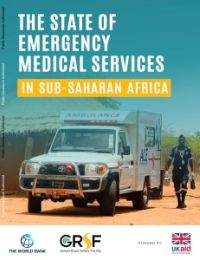
An evaluation of the various Emergency Medical Services (EMS) models and mechanisms in place in Sub-Saharan Africa (SSA) is critical in order to have a better understanding of what can be improved upon for effective pre-hospital and emergency care services (PECS). With grant funding provided by the World Bank’s Global Road Safety Facility (GRSF), this report aims explore the State of EMS Systems in Sub-Saharan Africa through a review of the models and mechanisms being developed across various States.
The premise of the report focuses on the fundamentals for effectively providing satisfactory treatment to those in need of urgent medical care, while also recognizing that there are multiple pathways, framed by the respective legislative, legal and regulatory enabling environments, towards a more formal and sustainable EMS model. It represents an effort to identify the major similarities and differences, as well as potential opportunities for greater coordination or collaboration, that can lead to the development of sound policy recommendations for fostering and expanding post-crash response services in the region.
High-level system information has been collected through questionnaires distributed to National Respondents in each country, for which 25 of 44 countries substantially responded as of April 2019 (collectively hereinafter referred to as SSA countries): Botswana, Burkina Faso, Burundi, Cabo Verde, Cameroon, Central African Republic, Chad, Comoros, Congo Brazzaville, Gabon, Lesotho, Liberia, Madagascar, Malawi, Mauritania, Niger, Rwanda, Senegal, Sierra Leone, Sudan, Tanzania, Togo, Uganda, Zambia and Zimbabwe. Missing data and discrepancies triggered a detailed review of laws and other regulatory acts, policy and plan.
The Report does not consider the advantages and disadvantages for the EMS models adopted by SSA countries, nor does it take a position on which regulatory approach should be applied, or measure the degree of EMS standards implementation and the success or failure of implementing various EMS policies. The principal aim of this report is to capture the current range of the standards and regulations in key areas of EMS systems across SSA.
The State of Emergency Medical Services in Sub-Saharan Africa is supported by UK Aid through the World Bank’s Global Road Safety Facility.

